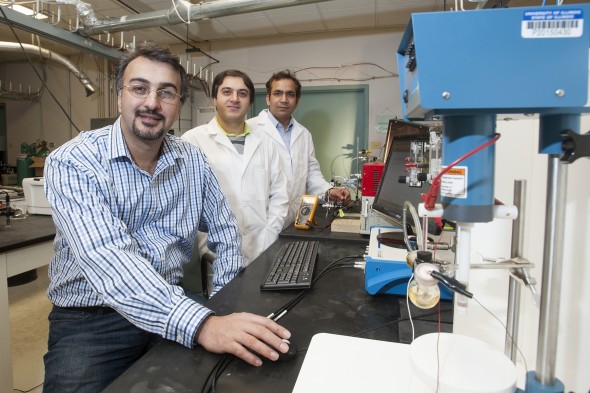Catalyst converts carbon dioxide to fuel

Researchers Amin Salehi-Khojin (from left), Mohammad Asadi and Bijandra Kumar. Photo: Roberta Dupuis-Devlin
UIC scientists synthesized a catalyst that improves their system for converting waste carbon dioxide into syngas, a precursor of gasoline and other energy-richproducts, bringing the process closer to commercial viability.
“Our whole purpose is to move from laboratory experiments to real-world applications,” said Amin Salehi-Khojin, professor of mechanical and industrial engineering.
“This is a real breakthrough that can take a waste gas — carbon dioxide — and use inexpensive catalysts to produce another source of energy at large-scale, while making a healthier environment.”
Salehi-Khojin and colleagues developed a two-step catalytic process that uses molybdenum disulfide and an ionic liquid to “reduce,” or transfer electrons, to carbon dioxide in a chemical reaction.
The new catalyst improves efficiency and lowers cost by replacing expensive metals like gold or silver in the reduction reaction.
The discovery is a big step toward industrialization, said Mohammad Asadi, graduate student and co-first author with postdoctoral fellow Bijandra Kumar, on the study published in the journal Nature Communications.
“With this catalyst, we can directly reduce carbon dioxide to syngas without the need for a secondary, expensive gasification process,” he said. In other chemical-reduction systems, the only reaction product is carbon monoxide. The new catalyst produces syngas, a mixture of carbon monoxide plus hydrogen.
The proportion of carbon monoxide to hydrogen in the syngas produced in the reaction can be easily manipulated using the new catalyst, Salehi-Khojin said.
Co-authors on the paper were Artem Baskin, Nikita Repnin, Davide Pisasale, Patrick Philips, Robert Klie, Petr Kral and Jeremiah Abiade of UIC; Brian Rose and Richard Haasch, Urbana-Champaign campus; and Wei Zhu of Dioxide Materials.
The study was supported by UIC’s Chancellor Innovation Fund, the American Chemical Society Petroleum Research Fund and the Herbert E. Paaren Graduate Fellowship.
